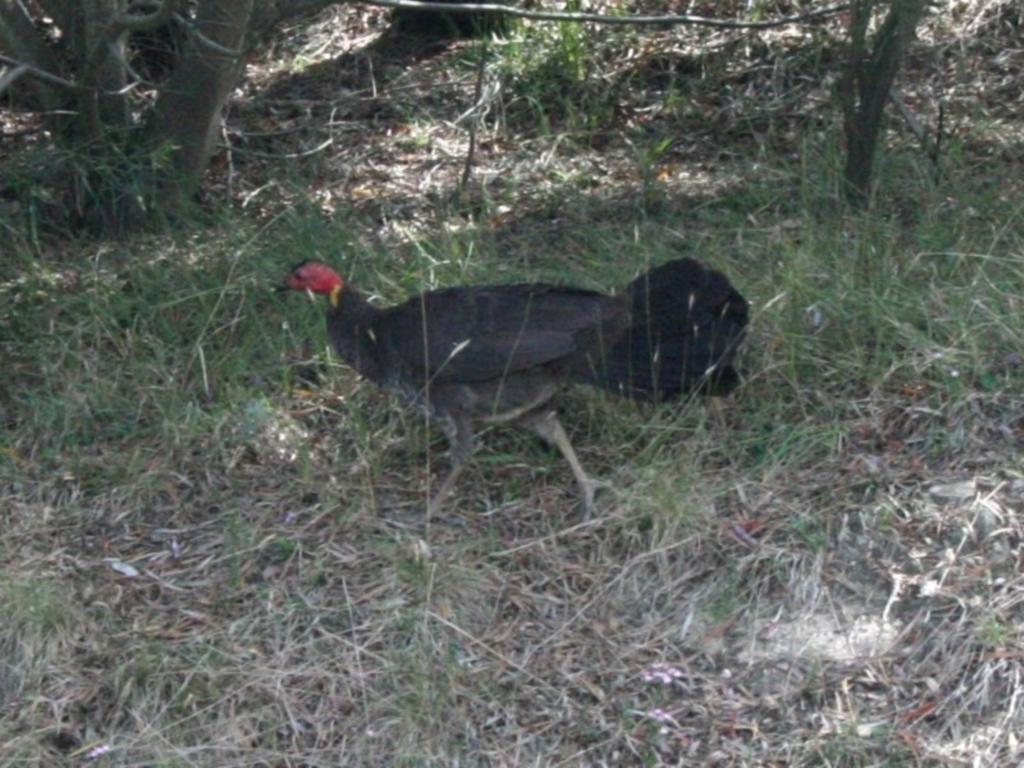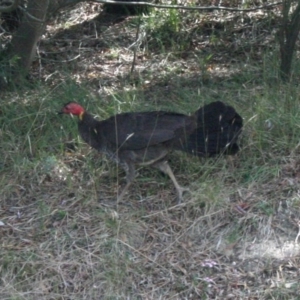Australian Brush-turkey at Bywong, NSW
Identification history
| Alectura lathami | 2 Nov 2016 | ChrisDavey | ||
| Alectura lathami | 29 Oct 2016 | ArcherCallaway | ||
| Alectura lathami (Australian Brush-turkey) | 29 Oct 2016 | michaelb | ||
| Unidentified | 29 Oct 2016 | davidmcdonald |
Identify this sighting
Please Login or Register to identify this sighting.
9 comments
michaelb
wrote:
30 Oct 2016
Hi David
What you have shown me is very interesting. I have suggested Alectura lathami (Australian Brush-turkey) as new species. Just to keep it simple from our point of view, can you please just reduce the notes so that it fits the space, or add the extra information in reply to this comment.
What you have shown me is very interesting. I have suggested Alectura lathami (Australian Brush-turkey) as new species. Just to keep it simple from our point of view, can you please just reduce the notes so that it fits the space, or add the extra information in reply to this comment.
davidmcdonald
wrote:
30 Oct 2016
Species name given as 'I don't known' as it is not listed. The bird is, of course, an Australian Brush-turkey Alectura lathami.
Observed and photographed by John-Pierre Favre who lives at 190 Newington Rd, Bywong. He wrote to the CanberraBirds email list on 20 Jan 12 http://bioacoustics.cse.unsw.edu.au/archives/html/canberrabirds/2012-01/msg00191.html :
‘We live in Bywong... About two weeks ago a Brush-turkey turned up on our 40 acre lot. He has been seen on various properties since that day. He comes and sleeps way up a gum tree near our house. This morning he was feeding on Black Wattle seeds that are in abundance at the moment. We know little about birds of Australia and would like to know if it is conceivable that Brush -turkeys live in our district. We have put notices via email to ask if he belongs to someone but got no answers. Can anyone give us some idea about this welcome arrival?’
He subsequently provided more details:
‘The bird was first spotted at Thelma Oberdorf’s place on Newington Road just before Christmas [2011]. He was spotted here for the first time some days later and was also seen at the Bookers’ place on Newington Road, a range of 2 km. He now seems to come to our place for the night and spends the early morning in an old chook yard near our house before disappearing. We don’t feed him as he seems to find enough wattle seeds and other stuff on our land. We’d hate to see him become dependent on us for food. You can approach him within a couple of metres before he quietly backs off.’
We wrote this up: McDonald, D & Favre, J-P 2012, 'The Australian Brush-turkey in Bywong: who’d have thunk it?', The Wamboin Whisper, February 2012, http://wamboincommunity.asn.au/thewhisper/content/support/archives/2012/1202%20Whisper.pdf, pp. 10-11.
I presume that this is an escaped aviary bird, though we have a valid historical record from the Lake George/Lake Bathurst area.
I have submitted the details to COG's Rarities Panel for their records.
Observed and photographed by John-Pierre Favre who lives at 190 Newington Rd, Bywong. He wrote to the CanberraBirds email list on 20 Jan 12 http://bioacoustics.cse.unsw.edu.au/archives/html/canberrabirds/2012-01/msg00191.html :
‘We live in Bywong... About two weeks ago a Brush-turkey turned up on our 40 acre lot. He has been seen on various properties since that day. He comes and sleeps way up a gum tree near our house. This morning he was feeding on Black Wattle seeds that are in abundance at the moment. We know little about birds of Australia and would like to know if it is conceivable that Brush -turkeys live in our district. We have put notices via email to ask if he belongs to someone but got no answers. Can anyone give us some idea about this welcome arrival?’
He subsequently provided more details:
‘The bird was first spotted at Thelma Oberdorf’s place on Newington Road just before Christmas [2011]. He was spotted here for the first time some days later and was also seen at the Bookers’ place on Newington Road, a range of 2 km. He now seems to come to our place for the night and spends the early morning in an old chook yard near our house before disappearing. We don’t feed him as he seems to find enough wattle seeds and other stuff on our land. We’d hate to see him become dependent on us for food. You can approach him within a couple of metres before he quietly backs off.’
We wrote this up: McDonald, D & Favre, J-P 2012, 'The Australian Brush-turkey in Bywong: who’d have thunk it?', The Wamboin Whisper, February 2012, http://wamboincommunity.asn.au/thewhisper/content/support/archives/2012/1202%20Whisper.pdf, pp. 10-11.
I presume that this is an escaped aviary bird, though we have a valid historical record from the Lake George/Lake Bathurst area.
I have submitted the details to COG's Rarities Panel for their records.
ArcherCallaway
wrote:
30 Oct 2016
Was the rarities submission a more recent thing or is their verdict published somewhere?
Also, were you there for the Brush-turkey talk at the last COG meeting?
Also, were you there for the Brush-turkey talk at the last COG meeting?
davidmcdonald
wrote:
30 Oct 2016
Hello Ryu. I submitted the photo and written details - the Wamboin Whisper article - to the RP. They replied, advising that the information will be kept on file. Since I did not see the bird I could not submit a formal Unusuals report. I don't think they accept second-hand reports.
And yes, I was at Ann Goth's presentation and asked her a question about the records of this species that she had in one of her slides. As a consequence I am currently drafting an article, for publication in the December 2016 issue of CBN (if accepted by the editor), assessing the validity (or otherwise) of the 18 brush-turkey records in the Canberra region of which I am aware.
And yes, I was at Ann Goth's presentation and asked her a question about the records of this species that she had in one of her slides. As a consequence I am currently drafting an article, for publication in the December 2016 issue of CBN (if accepted by the editor), assessing the validity (or otherwise) of the 18 brush-turkey records in the Canberra region of which I am aware.
galah681
wrote:
2 Nov 2016
There are suggestions in the stories from the early Tidbinbilla pioneers that there were brush turkeys in the area - hence the name Turkey hill at Tidbinbilla. Another story suggests that they are no longer in the district because they were all eaten.
davidmcdonald
wrote:
2 Nov 2016
Thank you for that comment. During the colonial period the term 'turkey' was used for bustards, brush-turkeys and lyrebirds.Turkey Hill in Tidbinbilla was almost certainly named after the Superb Lyrebird.
That said, I will be very grateful if you can let us have details of documentation, from that era, of Tidbinbilla pioneers mentioning Alectura lathami Australian Brush-turkey specifically, i.e. differentiating it from the lyrebird.
With thanks - David
That said, I will be very grateful if you can let us have details of documentation, from that era, of Tidbinbilla pioneers mentioning Alectura lathami Australian Brush-turkey specifically, i.e. differentiating it from the lyrebird.
With thanks - David
galah681
wrote:
3 Nov 2016
"Pioneers of the district" http://trove.nla.gov.au/newspaper/article/16383040?searchTerm=&searchLimits=l-publictag=Canberra+History - mentions both plains turkey (bustard) and tallegalla (brush turkey) in the area acquired for the ACT
In "To Green the Memory" by Monica Flint 1983 p24 referring to Mary Ann Green (1885-19110 - " She had seemingly contracted Rheumatic fever after getting soaked when she went out at night to save her young turkey chicks. She had often searched for her wandering turkeys and regularly found them on a nearby hill, later called Turkey hill" However, no evidence of what sort of turkey unfortunately.
In "To Green the Memory" by Monica Flint 1983 p24 referring to Mary Ann Green (1885-19110 - " She had seemingly contracted Rheumatic fever after getting soaked when she went out at night to save her young turkey chicks. She had often searched for her wandering turkeys and regularly found them on a nearby hill, later called Turkey hill" However, no evidence of what sort of turkey unfortunately.
davidmcdonald
wrote:
15 Dec 2019
Thank you for this reference. It was discussed in Green, E 1989, 'The Australian Brush-turkey (Alectura lathami) in the Canberra, ACT, region', Canberra Bird Notes, vol. 14, no. 4, pp. 103, http://canberrabirds.org.au/wp-content/canberra-bird-notes/cbnvol14no4.pdf. The author advised there that they were the domestic turkey Meleagris gallopavo.
Location information
- Coordinates 149.313636-35.203653
- Altitude 767.0m
- Maps QPRC LGA
- Places Bywong, NSW
Sighting information
- 1 Abundance
- 5 Jan 2012 08:54 AM Recorded on
- davidmcdonald Recorded by
Species information
- Alectura lathami Scientific name
- Australian Brush-turkey Common name
- Not Sensitive
- Non-local native
- Non-Invasive
- Up to 767m Recorded at altitude
- Machine learning
- External link More information





